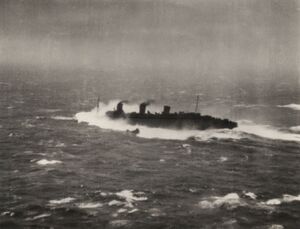Battle of the Byzantine Sea: Difference between revisions
No edit summary |
No edit summary |
||
| Line 69: | Line 69: | ||
===The Storm of the Grand Lady=== | ===The Storm of the Grand Lady=== | ||
[[File:The Grand Lady.jpg|thumb|left|HMTS Queen Silvana during a similar storm]] | [[File:The Grand Lady.jpg|thumb|left|HMTS Queen Silvana during a similar storm]] | ||
On the 19th of June, three days before the end of the war, the Queen Silvana was transiting the Revechi Channel en route to the captured port of Belgica when a storm kicked up approximately 5:28 PM. | |||
Revision as of 06:28, 10 August 2022
The Battle of the Byzantine Sea was a logistical operation undertaken by the Royal Renolion Army and the Royal Renolion Army during the Five Week War week war. The operation lasted from May 17th to June 26th, and would oversee the transport of troops to the frontline via the requisitioning of civilian passenger liners to act in service as troopships. This conflict is most famous for being the only conflict in the duration of the war in which Renolion loses were not directly tied to enemy actions.
Name
It's believed that the first person to refer to the battle as the Battle of the Byzantine Sea was head of the National Parliament Pio Raineri in a speech on May 20th, 1967. Other sources pin the name on Captain Gino Calvi of the troopship Queen Silvana, who stated on May 19th that "this battle will stretch the whole of the Byzantine span between us and them, and it's best we show them what we can do." Speculation remains to this day.
Early Encounters
On May 27th, 1967 the first reported sighting of a periscope would arrive from the troopship Imperator while under escort by the armed tugboat Trout. Though an attempt was made to investigate the sighting, the sonar faded out before the Trout could make it to the believed location of the submarine. A similar incident would occur on the return trip of the Imperator on the night of the 28th, the exception being that the submarine had surfaced for oxygen and to recharge it's batteries, however due to it's proximity to the two vessels the Trout was unable to depress it's guns to fire on it. In need of a solution top prevent the submarine escaping an posing a threat to the much larger Queen Silvana ten miles ahead, Captain [blank] of the Trout made the decision to ram it. Though crude, the damage done to the submarine was significant enough that it forced the crew to abandon, leading to the submarine's scuttling.
From May 30th to the 1st of June activity was low, but from the 2nd to the 8th of June a spike in debris was discovered along the usual transit route between Komspukov and Toloa, which seemed to be a result of mines laid by the submersible minelayer Grayfish. On June 10th, the troopships Renolion and Aqituo encountered a flight of four patrol aircraft, which were successfully downed by their 40mm mountings located on their bows and sterns.
The Storm of the Grand Lady
On the 19th of June, three days before the end of the war, the Queen Silvana was transiting the Revechi Channel en route to the captured port of Belgica when a storm kicked up approximately 5:28 PM.

